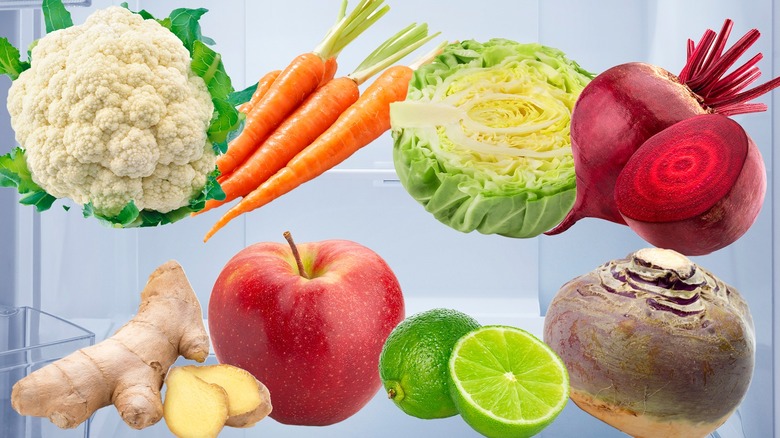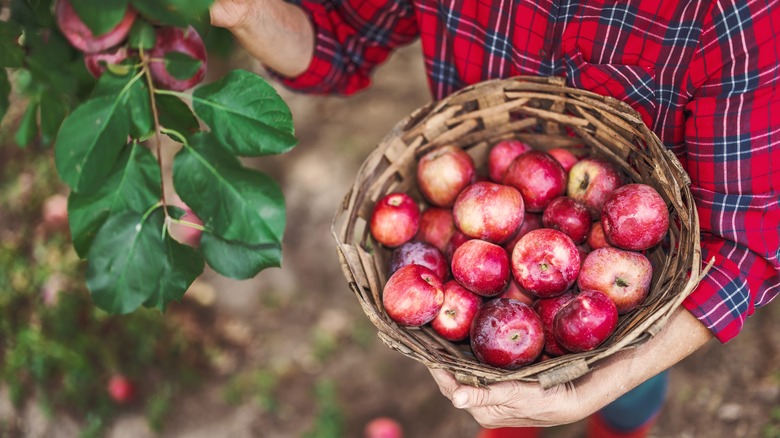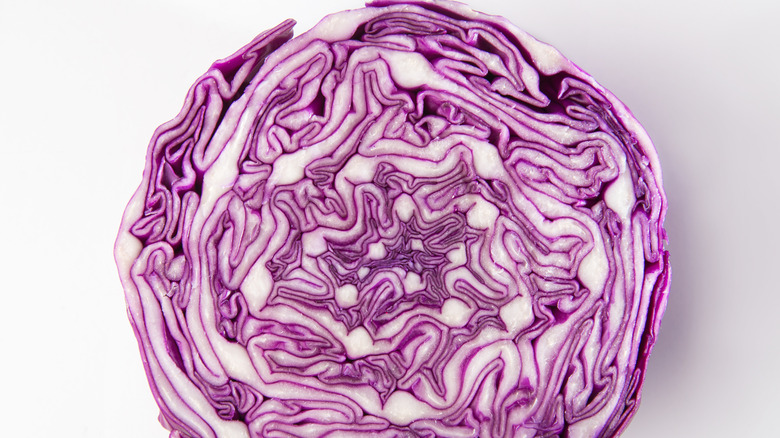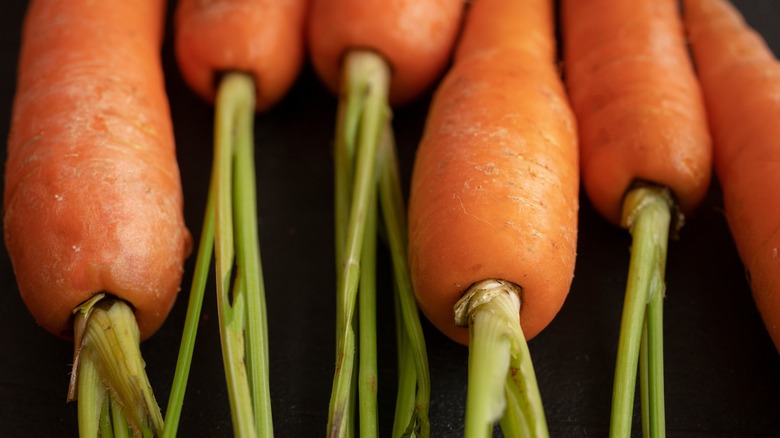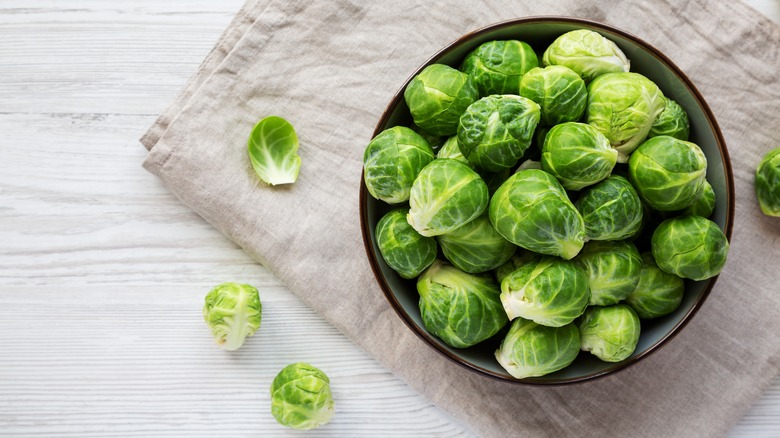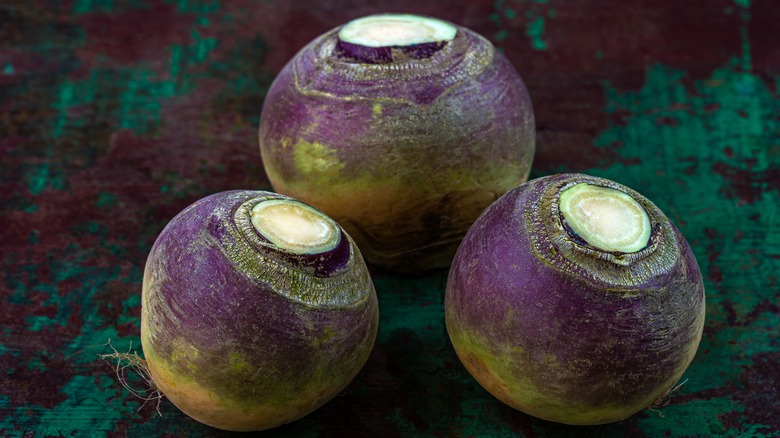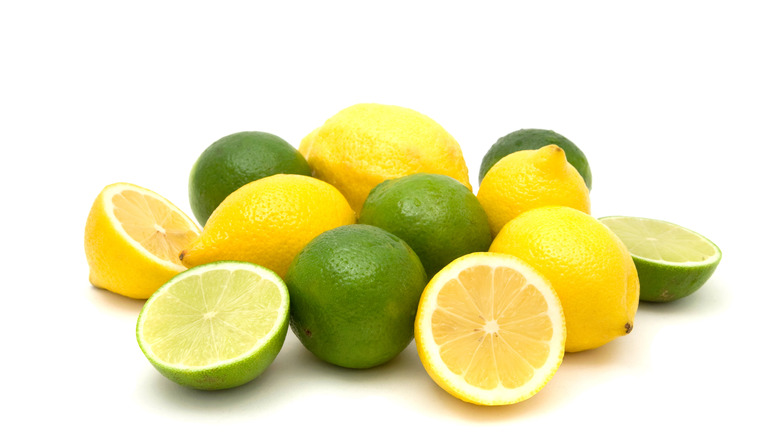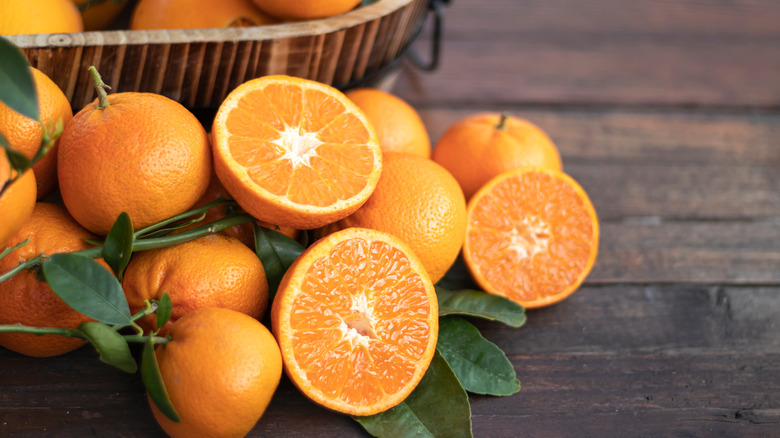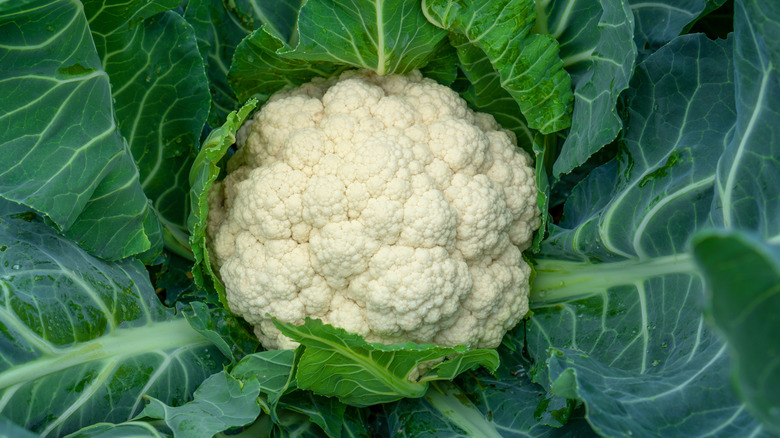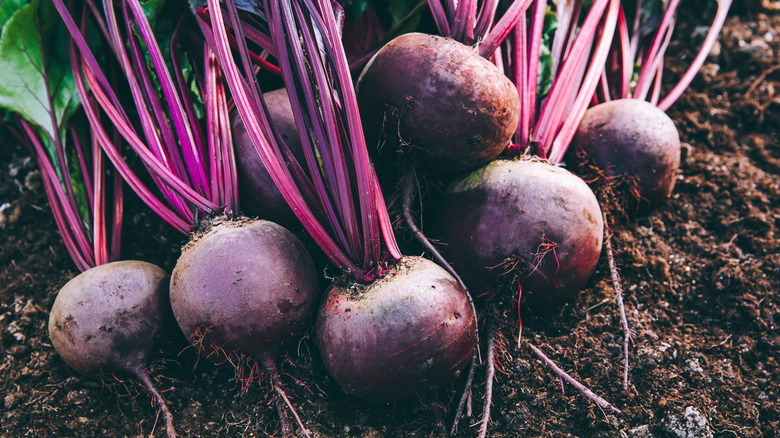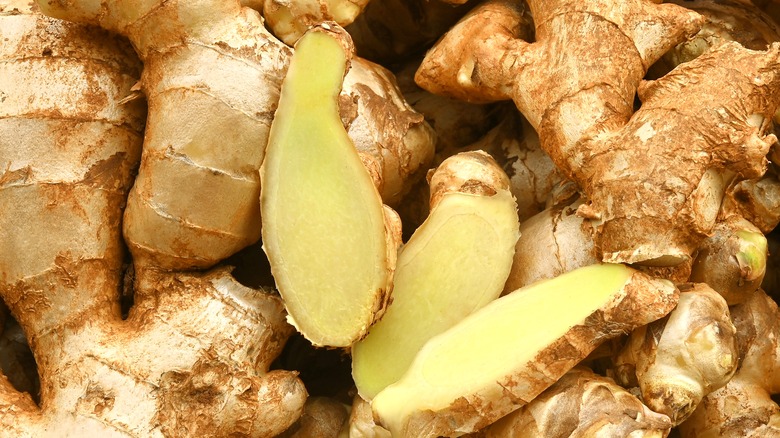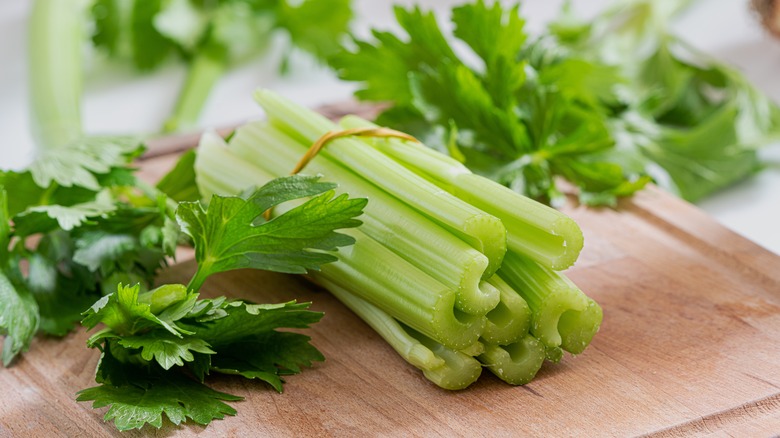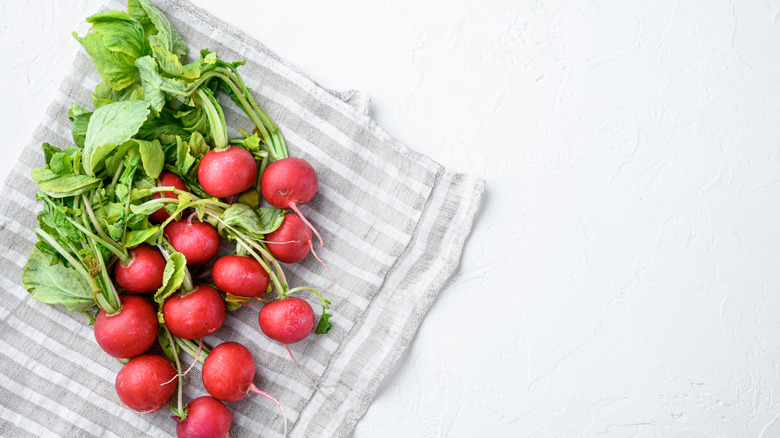12 Types Of Produce That Last The Longest In The Fridge
How many times have you gone shopping and optimistically filled your cart with fresh fruits and vegetables? You bring your bounty home and put everything in your fridge with big plans of making wholesome, vegetable-forward meals. But then maybe work keeps you late a few nights, then your friends are meeting up for dinner on the town, and by the end of the week, it's easier just to order takeout because you're exhausted. Suddenly you're faced with a fridge full of wilted produce. It happens to all of us. Some produce is just too fragile or temperamental to keep for more than a couple of days.
Fortunately, there are several varieties of vegetables and fruits that can actually withstand a longer stint in the fridge than others. So if you're the type who might be guilty of putting off that veggie lasagna until another night, you might want to start stocking up on some of these options that can tolerate a bit of a wait.
1. Apples
One of the main staples of fruit bowls for generations, apples can last a surprisingly long time if you store them properly. During the autumn, you might find yourself with an oversupply of apples, either as leftovers from baking projects or simply because you couldn't stay out of the idyllic orchards during prime harvest time. Luckily, apples are hearty fruits and can survive in your fridge for quite a while.
Even before you bring apples home from the supermarket, they've most likely been in storage anywhere from six to 12 months, depending on when they were harvested. The secret to keeping apples fresh-tasting is to maintain consistent temperatures. A consistent temperature ensures the integrity of the cell walls, meaning that the flavor and texture of your apples will stay out of the dreaded "mealy" zone. The best place in your fridge to keep your apples at a steady temperature is the crisper drawer, preferably in the back of the drawer where they won't be affected by temperature fluctuation of the door opening and closing. Your apples can last up to six to eight weeks in these cool conditions.
Another trick to keeping apples at their freshest is to make sure that the stems of the apples are present and there are no blemishes on the skin. An intact stem is a perfect barrier against bacteria and other microorganisms from getting into the interior of the apples and causing spoilage from the inside out.
2. Cabbage
Whether you enjoy a fresh cole slaw with your summer barbeque or you are partial to the pickled tang of kimchi, having cabbage on hand means that you'll never be short on side dishes. Don't be afraid to grab a head of cabbage on your next shopping run even if you don't plan on using it that night or even the next. Cabbage has a surprisingly long shelf life considering that it's a leafy green, which can be very fickle (I'm looking at you, baby spinach).
There are plenty of tips for cooking with cabbage, but our favorite is that it can last up to four months if you store it correctly. Cabbage already has an advantage because it's a cold-weather vegetable, accustomed to chilly conditions, so a nice cool fridge is an ideal environment. When you buy the head of cabbage, choose a head that has some thick outer leaves, which act as a protective barrier for the tender and tasty inner leaves. Don't wash the cabbage until just before you're ready to use it to prevent water droplets from becoming trapped between the leaf layers, which could lead to premature rotting.
The crisper drawer is the best place to store your whole head of cabbage until you're ready to use it. Once you've shredded or cut your cabbage, you should use it within a couple of days, since the chopped strands of cabbage are now more vulnerable to drying out, browning, and wilting.
3. Carrots
Carrots are a staple in so many dishes, either as a background flavor as part of a traditional mirepoix or as the star of a side dish. They're sweet, nutritious, and great just for snacking on raw. They also are very hearty and can last up to four weeks in the fridge if you follow some easy steps to keep your carrots fresh.
If you're looking for longevity in your carrots, skip the bags of pre-peeled baby carrots. Sure, they're adorable, but they're missing their protective outer skin, which leaves them open to drying out or being exposed to bacteria which can lead to spoiling. Instead, just go for full-sized, skin-on carrots. If they have the greens attached, be sure to break those off before storing your carrots, since they draw moisture away from the body of the vegetable.
Don't wash your carrots until right before you're ready to peel and use them. Instead, once the greens are removed, tuck the carrots into a large ziplock bag. This will keep the veggies from drying out in the arid environment of the fridge by trapping the natural moisture in an air-tight container.
4. Brussels sprouts
Brussels sprouts are a divisive vegetable. They are the smaller, sulfurous cousin of the cabbage. They're odiferous, no doubt, but cooked just right, they truly can be a magical experience. Roasted, sauteed, or air-fried, there are so many different ways that you can enjoy these adorable mini-cabbages.
Since they're so closely related to cabbage, it's no surprise that Brussels sprouts inherited the longevity of their bigger counterparts. With the proper care, brussels sprouts can last up to two weeks in your fridge. One of the secrets is to buy them on the stalk. Brussels sprouts grow on long branches, and you can often buy them on these stalks rather than plucked and loose. Keeping the sprouts on the stalk prevents the incursion of bacteria that can lead to rotting.
If you do buy Brussels sprouts loose, they can still keep for a good long time — just be sure that they have healthy, undamaged outer leaves which act as a protective barrier. Don't wash them until just before you use them and make sure that they're nice and dry before storing them in your refrigerator's crisper drawer.
5. Rutabaga
Rutabagas sort of sound like a made-up food. They're cold-weather root vegetables that resemble turnips but have a somewhat starchier texture. They make appearances in low-carb recipes as a replacement for potatoes, so if you've been searching for a keto-friendly spud substitute, you might want to grab a few rutabagas on your next shopping run.
Perhaps the greatest thing about rutabagas is that they can keep for up to four months in the fridge! Since they're a vegetable that is accustomed to colder climates, having a prolonged stay in the fridge isn't much of a stressor on these hearty root veg. If you buy them with their greens still intact, be sure to remove them before storing them. Wrapping your rutabagas in a damp paper towel and keeping them in a plastic bag will retain their moisture and prolong their life in the crisper drawer. Make sure that there isn't any bruising or damage to the outside of the rutabaga, as this can lead to premature spoiling. As long as everything is intact, you can enjoy your funny-sounding veggies for weeks after you buy them.
6. Lemons and limes
Citrus famously hails from sunny climates, so you might not immediately realize that they can last for extended periods in your fridge. Lemons and limes are important ingredients to keep in your kitchen. Whether you're adding a squeeze of acid to a seafood dish, or a tart wedge to a cocktail, it's imperative to have a healthy supply of citrus on hand.
Storing citrus in the fridge will keep it fresh for up to two weeks if you just put your lemons and limes into your crisper drawer loose. You can extend that life even further by putting them into an air-tight container, which will keep your lemons and limes from dying out and becoming little husks. Once they're sealed up, your citrus fruits will be good for at least a month.
This longevity depends on the integrity of the rind on your fruit. The tough outer shell of a lemon or lime is what protects it from the cold, dry environment of your fridge. So if you zest the rind for a recipe and just chuck the remaining fruit in the fridge, you'll end up with a very dehydrated and sad citrus in just a matter of days. So if you plan on zesting, you might also want to squeeze and store the juice for later use in order to get the maximum utility from your fruit.
7. Oranges
Speaking of citrus, oranges are another popular citrus fruit that definitely benefits from the cold interior of the fridge. Much like lemons and limes, you want to keep oranges whole when you store them and make sure that their rind is healthy and intact. If you do find yourself zesting or cutting oranges, then you'll want to use the remainder as soon as possible, either by juicing or even freezing the remaining fruit. Have you ever snacked on a frozen orange? Chilled heaven. And you can toss a whole frozen segment of orange in with your morning smoothies for that extra burst of vitamin C.
In order to keep your oranges at their peak juiciness, you'll want to either store them loose in the crisper drawer of the fridge or in the mesh bag that you purchased them in. Unlike lemons and limes, you don't want to restrict airflow over oranges, or you could risk them going mushy. If you keep them in the crisper drawer, oranges will last up to a month.
8. Cauliflower
With the popularity of keto and other low-carb diets on the rise, cauliflower is having a true moment in the sun. This versatile vegetable has become everything from pizza crust to rice to "mashed fauxtatoes". It is a master of disguise while also being truly delicious on its own. So if you find yourself stocking up on cauliflower, we don't blame you.
You can keep cauliflower in the fridge for up to three weeks. It's a hearty vegetable that can withstand colder temperatures well. Typically, when you purchase cauliflower from the store, it's already wrapped in plastic, and it's just fine to store it in that wrapping. If it's not pre-wrapped, you can give it a little bundle-up of your own at home. Just make sure that the head of cauliflower is nice and dry before you wrap it up, and make sure the plastic is loose enough for the vegetable to breathe.
Pre-sliced cauliflower can have a similarly long fridge life provided that you keep the cut-up bits dry and in an air-tight container like a ziplock bag or a Tupperware container.
9. Beets
Vibrant in color and rich in nutrition, beets are a gem of the root vegetable kingdom. They can be roasted, pickled, made into a hearty soup, or even incorporated into desserts like cake. So having a few beets on hand will never let you down. You can also use every part of the beet, sauteeing the greens while roasting the ruby-red root.
Proper beet storage is integral to preserving their freshness. Much like carrots, you want to remove the greens from the body of the beets because the greens want to wick the moisture away from the root of the vegetable. In order to preserve the integrity of your beets, you want to keep the body of the beets damp and hydrated.
Your beets can last up to three weeks in the fridge provided they stay cool and moist. You can store your unwashed beets in an airtight container with a damp paper towel in order to provide them with their best environment.
10. Ginger root
Zingy and unmistakable, fresh ginger is an ingredient that adds a very distinct brightness to whatever dish it's added to. A sliver in your tea will soothe whatever ails you and zesting it into cookies will make them snappier. Finely chopped fresh ginger is an amazing addition to traditional apple pie, as it compliments the tartness of the apples and sings with the cinnamon and nutmeg spices.
Oftentimes, you don't need too much fresh ginger for any one recipe since it's such a powerful flavor. So you might find yourself with a large amount of ginger root left over. The great news is that you can store ginger root in the fridge and keep it fresh for up to a month.
The secret to maintaining ginger root is to only peel exactly as much as you need. The knobby structure of a ginger root lends itself to having small chunks broken off of it while leaving the bulk of the plant intact. Keeping the skin on the remaining ginger root keeps the flesh from drying out prematurely. You should also keep your ginger root dry and in a ziplock bag or airtight container to keep its natural moisture in. You'll be able to keep returning to the same root for weeks at a time!
11. Celery
A common companion with carrots, you'd be surprised how often you find yourself using celery in recipes. It's one-third of a standard mirepoix, an integral addition to chicken or tuna salads, and the literal core of ants-on-a-log. It might get maligned for being a chewy and flavorless veggie, but it's actually way more versatile than most people expect, and it can be kept in your fridge for way longer than you might believe.
As we've seen before, the leaves of a head of celery are the enemy of freshness. You can strip off the leaves once you bring the celery bunch home and use them in a salad or saute them with your other greens to add a pleasant bitter note. Once the leaves are off, it's time to bust out the tin foil. That's right, aluminum foil is the key to preserving celery. Wrapping the whole bunch of celery in aluminum foil will keep it nice and crisp for up to a month.
12. Radishes
Radishes are tiny powerhouses of nutrition. They're loaded with antioxidants, vitamin C, and minerals. They're peppery and a bit spicy in flavor, so adding a few sliced radishes to a dish brings out a zesty dimension to the food. You can also pickle them to bring even more zing.
Like other root vegetables, you can keep radishes for up to two weeks, provided that you store them properly. The greens of radishes, like beets and carrots, shout be removed before you store them. Once the greens are off, you can seal the radishes into a ziplock bag or an airtight container to keep them crunchy. Then they should be tucked into the crisper drawer of your fridge.
You can keep your radishes hydrated by tucking a damp paper towel into the bag or container with them. If you notice the paper towel has dried out at any point, be sure to replace it.
